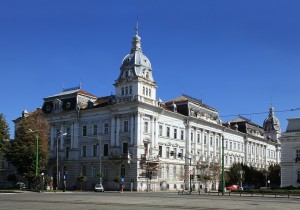The palace was built in the early 1880s, as ordered by the tradesman Hermann Gyula from Arad. The eclectic two-floor building with Neo-Baroque style elements originally included four luxurious apartments and a large courtyard. The entrance is guarded by two statues, Samson and Hercules, works belonging to the sculptor András Tóth.
History
Hermann Palace, one of the most outstanding palaces on Arad’s main boulevard, was built in the early 1880s by a wealthy merchant, Gyula Hermann. The building was originally designed with four luxurious apartments and a large courtyard.
The decoration of the building was designed by sculptor András Tóth (author of the Kossuth statue in Salonta, father of the famous Hungarian poet, Árpád Tóth). The palace’s eclectic decorative language is dominated by baroque stylistic elements. The monument is one of the most impressive examples of eclectic architecture in Arad.
Architecture
The eclectic-styled palace, with neo-baroque elements, has two floors, which originally incorporated four luxury apartments, and a spacious courtyard. The ground floor windows are framed by iron columns of baroque style. Specific style elements are the two loggias on the floor with baroque ornamentation. The entrance is guarded by the statues of Samson and Hercules, works belonging to the sculptor András Tóth.
Interesting facts
Sculptor András Tóth, author of the two statues at the entrance of Hermann Palace and of the Kossuth statue in Salonta, is the father of a famous hungarian poet, Árpád Tóth.
Similar tourist attractions
The building was built between 1892-1894 by Arad-Cenad Railway Company. The plans were made in the workshop of architect Miklós Ybl in Budapest and subsequently adapted by Lajos Jiraszek.
The palace of Szántay Lajos, an architect native of Arad, famous in Europe, is a brilliant epitome of Secession architecture, its grandeur highlighted by structural and decorative details alike.
This outstanding building in the heart of Arad belonged to baron Bohuș. The Palace is the work of local architect Ludovic Szántay and was inaugurated in 1913.





